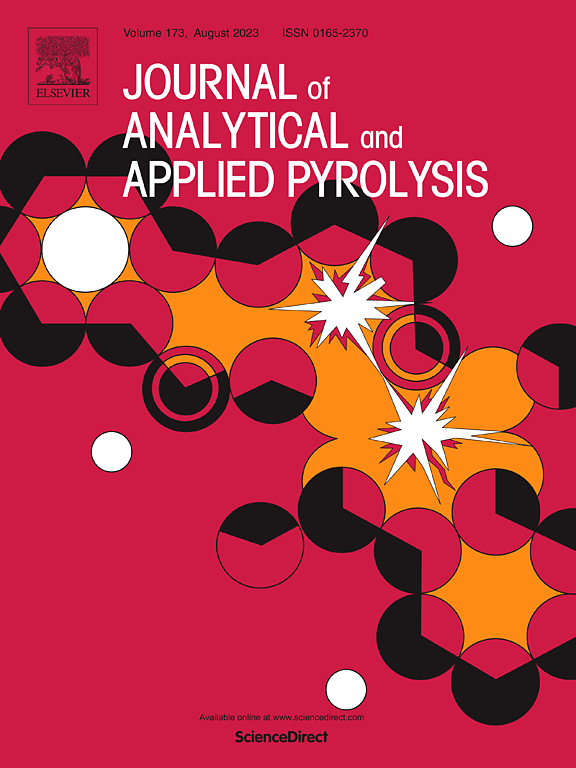用溶液燃烧合成的铁基氧化铝催化剂微波辅助热解液态烃:合成参数的影响
IF 5.8
2区 化学
Q1 CHEMISTRY, ANALYTICAL
引用次数: 0
摘要
铁基氧化铝(FeAlxOy)材料的微波吸收和催化特性使其能够用作催化剂,在微波辅助下通过热解碳氢化合物产生氢气和碳。溶液燃烧合成(SCS)是制造这些材料的一种很有前景的方法,但其热解性能仍有待提高。本研究调查了改变溶液燃烧合成参数如何影响柴油、汽油和原油的热解。测试了两种燃料(柠檬酸和甘氨酸)、四种铁铝摩尔比和两种加热模式(热板和熔炉)。通过初湿浸渍法制备了 Fe/γ-Al2O3 和 Fe/β-SiC 催化剂,以进行比较。在测试的三种化石燃料中,柴油产生的 H2 量最高,COx 量最低。选择用于 SCS 工艺的燃料和铁/铝比例对热解性能有很大影响,因为它们会影响对催化和微波吸收都很重要的特性。甘氨酸的使用导致催化剂表现出较高的 H2 产率和较低的 CO2 生成量,这可以用所揭示的结构差异来解释。铁:铝摩尔比的增加增加了磁损耗,从而加速了微波加热,但同时也增加了二氧化碳的生成量。在使用最佳 SCS 参数时,FeAlxOy 催化剂的性能优于 Fe/γ-Al2O3 和 Fe/β-SiC。SCS 催化剂较高的 H2 生成效率得益于其增强的微波吸收特性。扫描电子显微镜和能量色散 X 射线光谱显示,大直径 CNT 是通过尖端生长机制形成的。通过 Boudouard 反应证明了 SCS 催化剂的再生能力。本文章由计算机程序翻译,如有差异,请以英文原文为准。
Microwave-assisted pyrolysis of liquid hydrocarbons using iron-based alumina catalysts obtained by solution combustion synthesis: The effect of synthesis parameters
The microwave-absorbing and catalytic properties of iron-based alumina (FeAlxOy) materials have enabled their use as catalysts for the microwave-assisted generation of hydrogen and carbon via pyrolysis of hydrocarbons. Solution combustion synthesis (SCS) is a promising method to fabricate these materials, but the pyrolysis performance still needs to be improved. The present work investigated how altering the SCS parameters affects the pyrolysis of diesel fuel, gasoline, and crude oil. Two fuels (citric acid and glycine), four Fe:Al molar ratios, and two heating modes (hotplate and furnace) were tested. Fe/γ-Al2O3 and Fe/β-SiC catalysts were prepared via incipient wetness impregnation for comparison. Among the three fossil fuels tested, diesel fuel yielded the highest amounts of H2 and least amounts of COx. The choice of fuel for the SCS process and the Fe/Al ratio strongly affected pyrolysis performance as they influence properties important for both catalysis and microwave absorption. The use of glycine resulted in catalysts that exhibited high H2 yield and low CO2 generation, which is explained by the revealed structural differences. The increase in the Fe:Al molar ratio accelerated microwave heating by adding more magnetic loss but also increased the amount of COx. When the optimal SCS parameters were used, FeAlxOy catalysts outperformed Fe/γ-Al2O3 and Fe/β-SiC. The high H2 generation efficiency of the SCS catalysts is explained by their enhanced microwave-absorption properties. Scanning electron microscopy and energy dispersive X-ray spectroscopy revealed the formation of large-diameter CNTs via the tip-growth mechanism. The regeneration of SCS catalysts was demonstrated via the Boudouard reaction.
求助全文
通过发布文献求助,成功后即可免费获取论文全文。
去求助
来源期刊
CiteScore
9.10
自引率
11.70%
发文量
340
审稿时长
44 days
期刊介绍:
The Journal of Analytical and Applied Pyrolysis (JAAP) is devoted to the publication of papers dealing with innovative applications of pyrolysis processes, the characterization of products related to pyrolysis reactions, and investigations of reaction mechanism. To be considered by JAAP, a manuscript should present significant progress in these topics. The novelty must be satisfactorily argued in the cover letter. A manuscript with a cover letter to the editor not addressing the novelty is likely to be rejected without review.

 求助内容:
求助内容: 应助结果提醒方式:
应助结果提醒方式:


